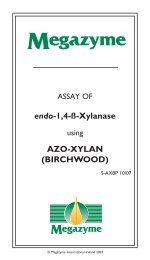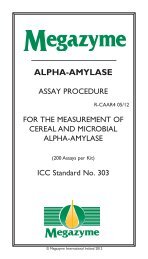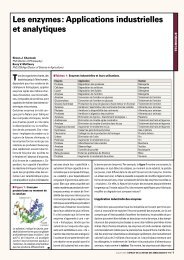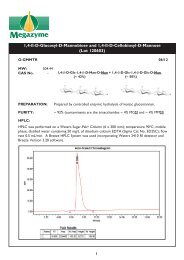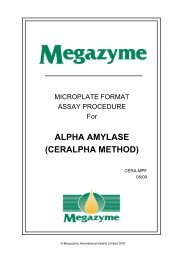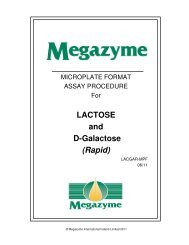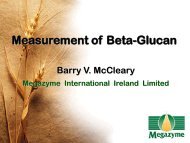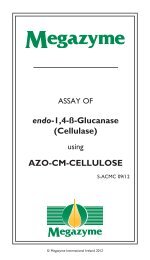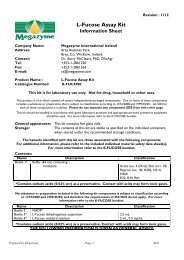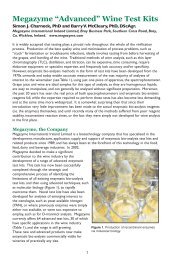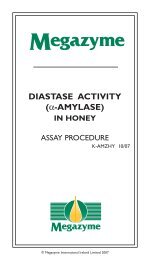L-LACTIC ACID (L-LACTATE) - Megazyme
L-LACTIC ACID (L-LACTATE) - Megazyme
L-LACTIC ACID (L-LACTATE) - Megazyme
Create successful ePaper yourself
Turn your PDF publications into a flip-book with our unique Google optimized e-Paper software.
L-<strong>LACTIC</strong> <strong>ACID</strong>(L-<strong>LACTATE</strong>)ASSAY PROCEDUREK-LATE 12/12(50 Assays per Kit) or(500 Microplate Assays per Kit) or(450 Auto-Analyser Assays per Kit)© <strong>Megazyme</strong> International Ireland 2012
INTRODUCTION:L-Lactic acid is found in many foods and beverages. Producednaturally by lactic acid bacteria, L-lactic acid is found in manyfermented milk products such as yogurt and cheese, and alsoin pickled vegetables and cured meats and fish. It is commonlysupplemented into foods and beverages (E270) where a tart flavouris desired, and is widely used as a non-volatile acidulant. In the eggindustry, this acid is a quality indicator, where levels above 200 mg/kgindicate spoilage by contamination or incubation. Similarly, the qualityof milk, and fruit and vegetables, can be established by measurementof L-lactic acid content. In the wine industry, the course of malolacticfermentation is monitored by following the falling level of L-malicacid, and the increasing level of L-lactic acid. In the chemical industry,L-lactic acid is a raw material in the production of compounds suchas polylactides and biologically degradable polymers, and applicationsalso exist for this acid in cosmetics and pharmaceuticals.PRINCIPLE:The quantification of L-lactic acid requires two enzyme reactions. Inthe first reaction catalysed by L-lactate dehydrogenase (L-LDH),L-lactic acid (L-lactate) is oxidised to pyruvate by nicotinamideadeninedinucleotide (NAD + ) (1).(L-LDH)(1) L-Lactate + NAD + pyruvate + NADH + H +However, since the equilibrium of reaction (1) lies firmly in the favourof L-lactic acid and NAD + , a further reaction is required to “trap” thepyruvate product. This is achieved by the conversion of pyruvate toD-alanine and 2-oxoglutarate, with the enzymeD-glutamate-pyruvate transaminase (D-GPT) in the presence of alarge excess of D-glutamate (2).(D-GPT)(2) Pyruvate + D-glutamate D-alanine + 2-oxoglutarateThe amount of NADH formed in the above coupled reaction isstoichiometric with the amount of L-lactic acid. It is the NADHwhich is measured by the increase in absorbance at 340 nm(Figure 1).1
SPECIFICITY, SENSITIVITY, LINEARITY ANDPRECISION:The assay is specific for L-lactic acid. In the assay of lithium L-lactate(MW = 96.0) results of approx. 98% (w/w) can be expected.The smallest differentiating absorbance for the assay is 0.005absorbance units. This corresponds to 0.107 mg/L of sample solutionat the maximum sample volume of 1.50 mL (or to 1.60 mg/L with asample volume of 0.1 mL). The detection limit is 0.214 mg/L, whichis derived from an absorbance difference of 0.010 and the maximumsample volume of 1.50 mL.The assay is linear over the range of 0.3 to 30 μg of L-lactic acidper assay. In duplicate determinations using one sample solution, anabsorbance difference of 0.005 to 0.010 may occur. With a samplevolume of 1.50 mL, this corresponds to a L-lactic acid concentrationof approx. 0.107 to 0.214 mg/L of sample solution. If the sampleis diluted during sample preparation, the result is multiplied by thedilution factor, F. If in sample preparation the sample is weighed, e.g.10 g/L, a difference of 0.02 to 0.05 g/100 g can be expected.INTERFERENCE:If the conversion of L-lactic acid has been completed within the timespecified in the assay (approx. 10 min), it can be generally concludedthat no interference has occurred. However, this can be furtherchecked by adding L-lactic acid (approx. 15 μg in 0.1 mL) to thecuvette on completion of the reaction. A significant increase in theabsorbance should be observed.Interfering substances in the sample being analysed can be identifiedby including an internal standard. Quantitative recovery of thisstandard would be expected. Losses in sample handling andextraction are identified by performing recovery experiments, i.e. byadding L-lactic acid to the sample in the initial extraction steps.SAFETY:The reagents used in the determination of L-lactic acid are nothazardous materials in the sense of the Hazardous SubstancesRegulations. However, the buffer concentrate contains sodium azide(0.02% w/v) as a preservative. The general safety measures that applyto all chemical substances should be adhered to.2
MICROPLATE ASSAY PROCEDURE:NOTES:1. The Microplate Assay Procedure for L-lactic acid can be performedusing either a single point standard or a full calibration curve.2. For each batch of samples that is applied to the determination ofL-lactic acid either a single point standard or a calibrationcurve must be performed concurrently using the samebatch of reagents.Wavelength: 340 nmMicroplate: 96-well (e.g. clear flat-bottomed, glass or plastic)Temperature: ~ 25°CFinal volume: 0.224 mLLinearity: 0.1-3 μg of L-lactic acid per well(in 0.01-0.2 mL sample volume)Pipette into wells Blank Sample Standarddistilled watersample solutionstandard solutionsolution 1 (buffer)solution 2 (NAD + )suspension 3 (GPT)0.160 mL--0.050 mL0.010 mL0.002 mL0.150 mL0.010 mL-0.050 mL0.010 mL0.002 mL0.150 mL-0.010 mL0.050 mL0.010 mL0.002 mLMix*, read the absorbances of the solutions (A 1 ) after approx. 3 minand start the reactions by addition of:suspension 4 (L-LDH) 0.002 mL 0.002 mL 0.002 mLMix*, read the absorbances of the solutions (A 2 ) at the end of thereaction (approx. 10 min). If the reaction has not stopped after 10min, continue to read the absorbances at 5 min intervals until theabsorbances increase constantly over 5 min**.* for example using microplate shaker, shake function on a microplate reader,or repeated aspiration (e.g. using a pipettor set at 50 - 100 μL volume).** if this “creep” rate is greater for the sample than for the blank, extrapolatethe sample absorbances back to the time of addition of suspension 4.CALCULATION (Microplate Assay Procedure):g/L = ∆Asample x g/L standard x F∆AstandardIf the sample is diluted during preparation, the result must bemultiplied by the dilution factor, F.8
SAMPLE PREPARATION:1. Sample dilution.The amount of L-lactic acid present in the cuvette (i.e. in the 0.1 mLof sample being analysed) should range between 0.3 and 30 μg. Thesample solution must therefore be diluted sufficiently to yield a L-lacticacid concentration between 0.003 and 0.30 g/L.Dilution TableEstimated concentration of Dilution DilutionL-lactic acid (g/L) with water factor (F)< 0.30 No dilution required 10.30-3.0 1 + 9 103.0-30 1 + 99 100> 30 1 + 999 1000If the value of ΔA L-lactic acid is too low (e.g. < 0.100), weigh out moresample or dilute less strongly. Alternatively, the sample volume tobe pipetted into the cuvette can be increased up to 1.50 mL, makingsure that the sum of the sample and distilled water components in thereaction is 1.60 mL and using the new sample volume in the equation.2. Sample clarification.a. Solutions:Carrez I solution. Dissolve 3.60 g of potassium hexacyanoferrate(II) {K 4 [Fe(CN) 6 ].3H 2 O} (Sigma cat. no. P-9387) in 100 mL of distilledwater. Store at room temperature.Carrez II solution. Dissolve 7.20 g of zinc sulphate (ZnSO 4 .7H 2 O)(Sigma cat. no. Z-4750) in 100 mL of distilled water. Store at roomtemperature.Sodium hydroxide (NaOH, 100 mM). Dissolve 4 g of NaOH in1 L of distilled water. Store at room temperature.b. Procedure:Pipette the liquid sample into a 100 mL volumetric flask which containsapprox. 60 mL of distilled water, or weigh sufficient quantity of thesample into a 100 mL volumetric flask and add 60 mL of distilled water.Carefully add 5 mL of Carrez I solution, 5 mL of Carrez II solution and10 mL of NaOH solution (100 mM). Mix after each addition. Fill thevolumetric flask to the mark, mix and filter.3. General considerations.(a) Liquid samples: for clear, slightly coloured liquid samples,adjust the pH to approx. 10 and use directly in the assay.9
(b) Acidic samples: if > 0.1 mL of an acidic sample is to be usedundiluted (such as wine or fruit juice), the pH of the solution shouldbe increased to approx. 10.0 using 2 M NaOH, and the solutionincubated at room temperature for 30 min.(c) Carbon dioxide: samples containing a significant amount ofcarbon dioxide, such as beer, should be degassed by increasing thepH to approx. 10.0 with 2 M NaOH and gentle stirring, or by stirringwith a glass rod.(d) Coloured samples: an additional sample blank, i.e. sample withno L-LDH, may be necessary in the case of coloured samples.(e) Strongly coloured samples: if used undiluted, stronglycoloured samples should be treated by the addition of 0.2 g ofpolyvinylpolypyrrolidone (PVPP) per 10 mL of sample. Shake the tubevigorously for 5 min and then filter through Whatman No. 1 filterpaper.(f) Solid samples: homogenise or crush solid samples in distilledwater and filter if necessary.(g) Samples containing fat: extract such samples with hot waterat a temperature above the melting point of the fat, e.g. in a 100 mLvolumetric flask at 60°C. Allow to cool to room temperature and fillthe volumetric flask to the mark with distilled water. Store on ice orin a refrigerator for 15-30 min to allow the fat to separate and thenfilter. Discard the first few mL of filtrate, and use the clear supernatant(which may be slightly opalescent) for assay. Alternatively, clarify withCarrez reagents.(h) Samples containing protein: deproteinise samples containingprotein by adding an equal volume of ice-cold 1 M perchloric acid withmixing. Centrifuge at 1,500 g for 10 min and neutralise the supernatantwith 1 M KOH. Alternatively use Carrez reagents.SAMPLE PREPARATION EXAMPLES:(a) Determination of free L-lactic acid in wine.The free L-lactic acid concentration [F] of white and red wine cangenerally be determined without any sample treatment (exceptdilution according to the dilution table). Typically, a dilution of 1:10and sample volume of 0.1 mL are satisfactory.(b) Determination of free and esterified L-lactic acid inwine.The concentration of both free and esterified L-lactic acid [F + E] inwhite and red wine can be determined as follows: add 2 mL of2 M NaOH to 20 mL of wine and heat under reflux for 15 min withstirring. After cooling, carefully adjust the pH of the solution to 10.010
with 1 M H 2 SO 4 and adjust the volume to 100 mL with distilledwater. Then analyse the sample according to the general procedure,with dilution where necessary. Typically, no further dilution is requiredand a sample volume of 0.1 mL is satisfactory.The concentration obtained is the sum of the free and esterifiedL-lactic acid [F + E], and thus the esterified L-lactic acid concentrationalone [E] can be calculated as follows:[E] = [F + E] – [F](c) Determination of L-lactic acid in beer.The L-lactic acid concentration of beer can generally be determinedwithout any sample treatment, except removal of carbon dioxideby stirring for approx. 1 min with a glass rod. Typically, no dilution isrequired and a sample volume of 0.2 mL is satisfactory.11[g/L](d) Determination of L-lactic acid in yogurt and milk.Accurately weigh approx. 1 g of homogenised yogurt or 10 g of milkinto a 100 mL volumetric flask containing 60 mL of distilled water. Addthe following solutions and mix after each addition: 2 mL of Carrez Isolution, 2 mL of Carrez II solution and 4 mL of NaOH solution(100 mM). Fill up to the mark with distilled water, mix and filter.Typically, no further dilution is required and sample volumes of 0.1 mL (foryogurt) and 1.0 mL (for milk) are satisfactory.(e) Determination of L-lactic acid in cheese.Accurately weigh approx. 1 g of grated cheese into a 100 mLvolumetric flask containing approx. 70 mL of distilled water and heatat 60°C with occasional shaking for 20 min, or until fully dispersed.Fill up to the mark with distilled water, place in a refrigerator (or icewater)for approx. 20 min to allow separation of the fat, and thenfilter. Typically, no dilution is required and a sample volume of 0.1 mL issatisfactory.(f) Determination of L-lactic acid in vinegar and vinegarcontainingliquids.The L-lactic acid concentration of vinegar or other pickling liquidscan generally be determined without any sample treatment (exceptfiltration where necessary and dilution according to the dilutiontable). Typically, no dilution is required and a sample volume of 0.1 mL issatisfactory.(g) Determination of L-lactic acid in sauerkraut juice.The L-lactic acid concentration of sauerkraut juice can generally bedetermined without any sample treatment (except filtration wherenecessary and dilution according to the dilution table). Typically, adilution of 1:100 and sample volume of 0.1 mL are satisfactory.
(h) Determination of L-lactic acid in meat products.Accurately weigh approx. 5 g of homogenised sample into a beakercontaining 20 mL of 1 M perchloric acid and homogenise with anUltraturrax ® (or equivalent) for 5 min. Add approx. 40 mL of distilledwater and adjust the pH to approx. 10.0 with 2 M KOH, using pH teststrips. Transfer the contents quantitatively to a 100 mL volumetricflask and fill to the mark with distilled water (if a fat layer develops,make sure this is above the mark, and the aqueous layer is at themark). Place in a refrigerator (or ice-water) for approx. 20 min toallow separation of fat and precipitation of potassium perchlorate.Filter, discarding the first few mL of filtrate and use the clear possiblyslightly turbid solution diluted, if necessary, for the assay. Typically, adilution of 1:2 and sample volume of 0.1 mL are satisfactory.(i) Determination of L-lactic acid in liquid whole egg.Homogenise the whole egg sample by vigorous stirring and accuratelyweigh approx. 10 g into a 50 mL volumetric flask containing approx.20 mL of distilled water. Add 2 drops of n-octanol and heat at approx.100°C with occasional shaking for 15 min and then allow to cool.With mixing after each addition, add 2 mL of concentrated CarrezI solution {15 g of K 4 [Fe(CN) 6 ].3H 2 O in 100 mL of distilled water}and 2 mL of concentrated Carrez II solution (30 g of ZnSO 4 .7H 2 Oin 100 mL of distilled water). Fill up to the mark with 0.1 M NaOH,thoroughly mix and filter. Typically, no further dilution is required and asample volume of 0.1 mL is satisfactory for contaminated or incubated eggs,or 0.5 mL for fresh eggs.The L-lactic acid content of whole egg powder is determined byaccurately weighing approx. 2 g of whole egg powder into a volumetricflask containing 25 mL of distilled water. After mixing, add 2 drops ofn-octanol and proceed as described above, except after the addition ofconcentrated Carrez II solution, the pH should be adjusted to 9.0 using1 M NaOH. Typically, no further dilution is required and a sample volumeof 0.1 mL is satisfactory for poor quality egg powder, or 0.5 mL for goodquality egg powder.(j) Determination of L-lactic acid in vegetable juices, fruitjuices and similar beverages.Dilute the sample to yield an L-lactic acid concentration of less than0.35 g/L (see dilution table). Clear, neutral solutions can generally bedetermined without any sample treatment. Turbid liquids generallyonly require filtering before the dilution step.If coloured vegetable juice (such as tomato juice) requiresdecolourising, proceed as follows: accurately weigh approx. 5 g ofhomogenised sample into a 100 mL volumetric flask containing 60 mL12
of distilled water. Add the following solutions and mix after eachaddition: 2 mL of Carrez I solution, 2 mL of Carrez II solution and4 mL of 0.1 M NaOH solution. Fill up to the mark with distilled water,mix and filter. Typically, no further dilution is required and a sample volumeof 0.1 mL is satisfactory.If coloured fruit juice (such as orange juice) requires decolourising,proceed as follows: adjust 25 mL of filtered sample to a pH of approx.10.0 using 2 M NaOH. Quantitatively transfer the solution to a 50 mLvolumetric flask and adjust to volume with distilled water. Transferto a beaker and add 1 g of PVPP, stir for 2 min and filter throughWhatman No. 1 (9 cm) filter paper. Typically, no further dilution isrequired and a sample volume of 0.1 mL is satisfactory.(k) Determination of L-lactic acid in whole blood samples.a. Solutions:Concentrated Carrez I solution. Dissolve 30 g of potassiumhexacyanoferrate (II) {K 4 [Fe(CN) 6 ].3H 2 O} (Sigma cat. no. P-9387) in200 mL of distilled water. Store at room temperature.Concentrated Carrez II solution. Dissolve 60 g of zinc sulphate{ZnSO 4 .7H 2 O} (Sigma cat. no. Z-4750) in 200 mL of distilled water.Store at room temperature.b. Procedure:Heat 1 mL of whole blood sample at approx. 80°C for 20 min in amicrofuge tube then centrifuge at 13,000 x g for 10 min and recoverthe supernatant. Add 20 µL Carrez Reagent II and mix thoroughly,then add 20 µL Carrez Reagent I and mix thoroughly. Centrifugethe sample again at 13,000 x g for 10 min and recover the clarifiedsupernatant for use in the assay. If required, dilute the sampleappropriately in distilled water for the assay.Note: The final volume of the clarified supernatant will beapproximately one quarter of the starting volume of the originalsample. Therefore adjust the volume of the starting material asrequired to obtain sufficient volume of clarified sample for the test.(l) Determination of L-lactic acid in biological tissue samples.Accurately weigh approx. 5 g of representative biological tissue intoa 100 mL Duran ® bottle. Add 20 mL of 1 M perchloric acid andhomogenise for 2 min using a Ultraturrax ® or Polytron ® homogeniser(or equivalent). Quantitatively transfer to a 40 mL glass beakerand adjust the pH to approx. 8.0 using 2 M KOH. Quantitativelytransfer to a 100 mL volumetric flask and adjust to the mark withdistilled water (ensuring the fat containing layer is “above” the mark,and the aqueous layer is “at” the mark). Store on ice for 20 minto precipitate potassium perchlorate and allow separation of the13
fat (if present). Centrifuge an appropriate volume of the sample at13,000 x g for 10 min and recover the clarified supernatant for usein the assay, alternatively filter through Whatman No. 1 filter paper,discarding the first 3-5 mL, and use the clear filtrate for the assay.If required, dilute the sample appropriately in distilled water for theassay.Note: The amount of starting material and volumes used can beadjusted accordingly depending on the amount of analyte present inthe sample.(m) Determination of L-lactic acid in biological fluid samples(e.g. urine and serum).For some biological fluid samples it may be sufficient to testthem directly without any sample preparation other thanappropriate dilution in distilled water. If this is not adequate thendeproteinisation with either perchloric acid or trichloracetic acid maybe required.Deproteinise biological samples by adding an equal volume of ice-cold1 M perchloric acid with mixing. Centrifuge an appropriate volumeof the sample at 1,500 x g for 10 min and recover the supernatantfor use in the assay, alternatively filter through Whatman No. 1 filterpaper, discarding the first 3-5 mL, and use the filtrate for the assay.If required, dilute the sample appropriately in distilled water for theassay. Alternatively, use 50% (w/v) trichloroacetic acid instead ofperchloric acid.REFERENCE:Noll, F. (1988). L-(+)-Lactate. In Methods of Enzymatic Analysis(Bergmeyer, H. U., ed.), 3rd ed., Vol.VI, pp. 582-588, VCH Publishers(UK) Ltd., Cambridge, UK.14
<strong>Megazyme</strong> International Ireland,Bray Business Park, Bray,Co. Wicklow,IRELAND.Telephone: (353.1) 286 1220Facsimile: (353.1) 286 1264Internet: www.megazyme.comE-Mail: info@megazyme.comWITHOUT GUARANTEEThe information contained in this booklet is, to the best of our knowledge, true and accurate, butsince the conditions of use are beyond our control, no warranty is given or is implied in respect ofany recommendation or suggestions which may be made or that any use will not infringe any patents.15




